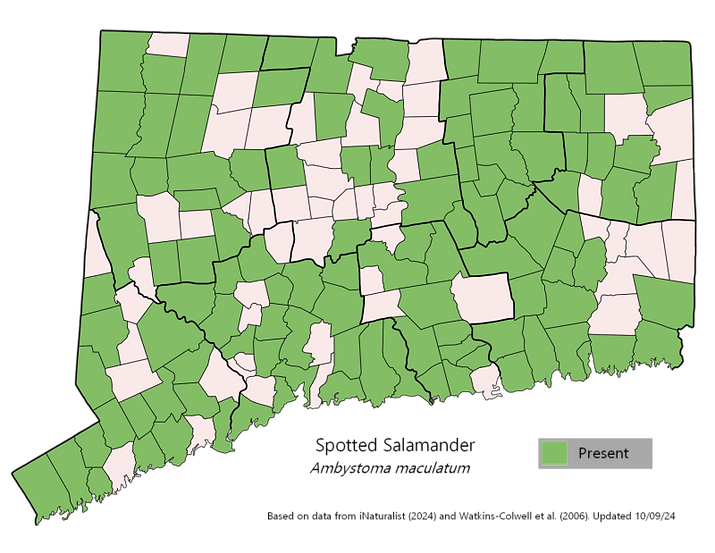Spotted salamander
Ambystoma maculatum
Conservation Status:
State Status: Secure (NatureServe, 2025)
Global Assessment: Least Concern (IUCN, 2020)
Description
Spotted salamanders grow up to nine inches long (Watkins-Colwell, 2025). They are black with large yellow spots. They have wide snouts and laterally flattened tails.
Habitat
These salamanders can be found in forests and around vernal pools.
Behavior
Spotted salamanders spend most of their time in burrows underground. They emerge during the breeding season. This species eats invertebrates, like insects, slugs, and worms. Breeding occurs in the early spring in vernal pools. Eggs are laid in clumps and hatch into aquatic larvae.
Range

References
iNaturalist. (2024). Observations. California Academy of the Sciences / National Geographic Society. https://www.inaturalist.org/observations?place_id=49&taxon_id=26790.
International Union for Conservation Of Nature and Natural Resources. (2020, December 18). Spotted Salamander. https://www.iucnredlist.org/species/59064/193224401.
NatureServe. (2025, January 31). Ambystoma maculatum. https://explorer.natureserve.org/Taxon/ELEMENT_GLOBAL.2.104612/Ambystoma_maculatum.
Watkins-Colwell, G. J. (2025). Spotted Salamander - Ambystoma maculatum. Yale Peabody Museum. https://peabody.yale.edu/explore/collections/herpetology/guide-amphibians-reptiles-connecticut.
Watkins-Colwell, G. J. et al. (2006). New Distribution Records for Amphibians and Reptiles in Connecticut, with Notes on the Status of an Introduced Species. Sacred Heart University. https://digitalcommons.sacredheart.edu/cgi/viewcontent.cgi?article=1058&context=bio_fac.
Page updated March 29, 2025
